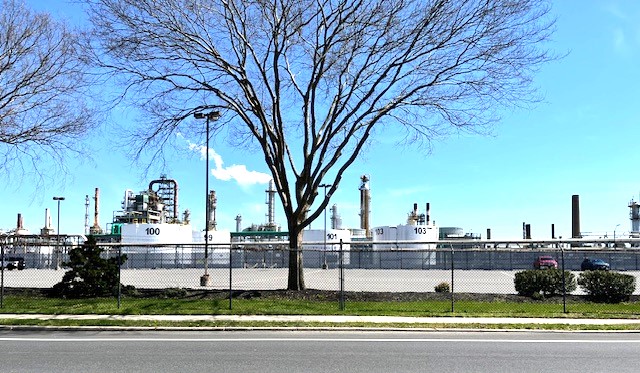Environmentalists sue EPA to reassess a toxic chemical used at Monroe Energy
Reprinted from Pennsylvania Capital-Star
By: Peter Hall – July 14, 2025 5:51 am
Sandwiched between the Delaware River and closely spaced homes, the Monroe Energy oil refinery in Trainer exemplifies the need for better regulation of a dangerous chemical used around the country to produce high-octane gasoline, environmental groups said.
If highly reactive hydrofluoric acid (HF) was released from the Delaware County refinery, it could form a ground-hugging cloud extending up to 17 miles and affecting as many as 1.9 million people in addition to delicate ecosystems nearby. HF attacks the human body causing burns, organ damage and death, a lawsuit against the U.S. Environmental Protection Agency claims.
The Philadelphia-based Clean Air Council, the Natural Resources Defense Council and California-based Communities for a Better Environment are suing the EPA in federal court, asking a judge to order the agency to reassess its regulations on the chemical.
Filed last Tuesday in U.S. District Court for the Central District of California, the suit follows the EPA’s rejection of a petition by the groups asking the agency to eliminate unreasonable risks from the use of HF at oil refineries. An EPA spokesperson said the agency has a longstanding practice of not commenting on pending litigation.
If you find yourself turning to our coverage more and more, please consider making a donation to strengthen our independent, nonprofit newsroom.
SUPPORT FOR SUIT
HF is used to increase the octane rating of gasoline during the refining process. The groups argue in their lawsuit that more than 40 oil refineries across the country still use HF despite the availability of safer alternatives. The chemical also presents a hazard as it is transported by truck and rail from the only plant where it is manufactured, in Louisiana.
“Needlessly risking release of this extremely hazardous chemical in our densely-packed region where so many people could be injured or killed is reckless. All the other refineries in Pennsylvania manage to use safer alternatives,” Clean Air Council Executive Director Alex Bomstein said in a statement.
MONROE NOT A DEFENDANT
Monroe Energy, a subsidiary of Delta Airlines, is not a defendant in the lawsuit, which also details the risks to populations surrounding refineries that use HF in the Los Angeles and Chicago areas.
A spokesperson for Monroe said the safe operation of the refinery is of paramount importance and the plant’s alkylation unit, where HF is used, is constantly inspected. The company has invested millions of dollars in safety systems for the unit, spokesperson Matt McGlaughlin said.
“Monroe Energy has a robust safety culture and a strong safety record that reflects this, having received numerous accolades for our safety performance over the years,” McLaughlin said, noting they include awards from the state and industry groups.
Delaware County spokesperson Ryan Herlinger said the county’s Hazardous Materials Response Team is prepared to respond to a release of HF from the Monroe Energy refinery.
“Delaware County takes the risks associated with HF seriously and maintains the resources, training, and protocols necessary to respond effectively and support our communities,” Herlinger said.
Composed of a single hydrogen and a single fluorine atom, both highly reactive elements by themselves, HF can cause respiratory problems and skin burns in lower concentrations. At higher levels, the chemical can cause gruesome and often fatal injuries by dissolving skin, muscle and bone.
“Poison acid clouds engulfing refinery communities and transit corridors sounds like a horror movie, but it’s a real possibility as long as EPA refuses to engage,” Matthew Tejada, senior vice president of environmental health at NRDC, said.
The lawsuit lists numerous releases of HF that caused injuries, including a 1987 incident in which a cloud of acid blanketed a Texas neighborhood. But south Philadelphia was the site of a near miss that could have had catastrophic consequences.
In the wee hours of June 21, 2019, a fire and massive explosion rocked the Philadelphia Energy Solutions oil refinery, hurling massive pieces of equipment hundreds of yards, with some landing on the other side of the Schuylkill River. More than 5,000 pounds of HF were released along with propane and other refining byproducts.
The U.S. Chemical Safety and Hazard Investigation Board found the cause of the blast was a 50-year-old section of pipe that ruptured and released liquid propane into the alkylation unit where HF was being used. The Trump administration’s budget for next year eliminates funding for the board, effectively shutting it down.
“A heroic worker was able to divert most of the refinery’s HF inventory — 339,000 pounds — to underground tanks, helping prevent an even greater catastrophe,” the lawsuit says, noting the incident injured five refinery workers and one firefighter, but damaged the plant so badly it never reopened.
Annie Fox, a Clean Air Council employee who works with residents in Trainer, Marcus Hook and other communities around the Monroe Energy plant, said the plant has health impacts on people who live “literally across the street.”
On Thursday, people in Delaware County reported a strong odor of sulfur or gasoline after a power failure forced an emergency shut down of parts of the plant. A towering flame and column of black smoke were emitted from the refinery’s flare stack, videos on social media showed.
“That is one of the reasons why Trainer is representative of the refineries across the country that still use HF,” Fox said.
NO EMERGENCY PLAN SINCE CROZER CLOSED?
She added that the recent closure of Crozer-Chester Medical Center means that the nearest emergency room is at least 20 minutes away and people say they have little guidance on what to do in a serious emergency.
“They’re not putting out emergency response plans. They’re not educating the medical personnel,” Fox said. “One resident who has lived there her entire life said they used to do very serious drills if there was an explosion there.”
According to the NRDC, the Trainer refinery has had five releases of HF since 1990, although only one happened since Monroe Energy took ownership of the plant in 2012 and none affected members of the public. In 2019, eight employees were exposed to HF during maintenance; five required hospitalization.
McGlaughlin, the Monroe Energy spokesperson, said the company has worked closely for years with the Delaware County Local Emergency Planning Committee and hospitals to provide information about what to do in the event of an HF release.
The county haz-mat team is certified by the state to handle highly hazardous chemical releases and equipped with specialized tools to detect such materials, including HF. Members of the team receive specialized training in HF response and carry a supply of the front-line treatment for exposure, Herlinger, the county spokesperson, said.
Monroe Energy also conducts joint training with local fire companies, including hazardous materials response.
“We work closely with local first responders in the Delaware Valley, a number of whom are also team members here at the refinery, who in turn share their learnings and knowledge with responders in their communities as well,” McGlaughlin said.

